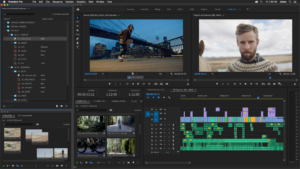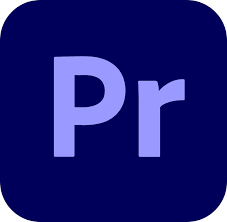Introduction to Adobe Premiere Pro
Adobe Premiere Pro is one of the world’s most powerful and widely-used video editing software applications. Created by Adobe Systems, it’s part of the Adobe Creative Cloud suite and is trusted by professionals in film, television, and content creation. From YouTubers to Hollywood studios, Premiere Pro delivers robust tools, advanced editing features, and seamless integration with other Adobe apps like After Effects, Photoshop, and Audition.

Key Features of Adobe Premiere Pro
1. Professional Video Editing Tools
Premiere Pro offers a timeline-based editing interface, perfect for beginners and pros alike. You can import, trim, cut, splice, and arrange clips on multiple tracks. It supports multicam editing, slip and slide tools, and real-time preview, allowing editors to work efficiently.
2. Broad File Format Support
It handles nearly every video, audio, and image format you can think of, including:
-
Video: MP4, MOV, AVI, MXF, etc.
-
Audio: MP3, WAV, AAC, etc.
-
Image: JPG, PNG, PSD (Photoshop), and more.
3. Adobe Sensei AI Integration
Adobe has integrated its artificial intelligence engine “Sensei” into Premiere Pro. It automates tasks like scene detection, audio ducking, and color matching, drastically reducing manual effort.
4. Powerful Color Grading Tools
Lumetri Color panel provides deep color correction and grading abilities. You can:
-
Adjust white balance
-
Apply LUTs (Look-Up Tables)
-
Correct exposure and contrast
-
Add cinematic looks
5. Audio Editing Capabilities
While Adobe Audition handles full-scale audio post-production, Premiere Pro itself includes tools for:
-
Mixing multiple audio tracks
-
Removing background noise
-
Applying EQ and reverb
-
Syncing external audio from recorders
6. Motion Graphics & Effects
Premiere Pro works hand-in-hand with Adobe After Effects. However, it also provides its own library of transitions, titles, and effects. The Essential Graphics panel allows you to build or use pre-designed motion templates (MOGRTs).
7. Seamless Adobe Creative Cloud Integration
Premiere Pro works perfectly with:
-
After Effects (for motion graphics)
-
Photoshop (image editing)
-
Illustrator (vector graphics)
-
Audition (audio editing)
Shared Libraries and Creative Cloud syncing also make team collaboration easier.
8. VR and 360-Degree Video Support
For creators in immersive media, Premiere Pro offers:
-
360-degree editing tools
-
VR viewing modes
-
Spatial audio editing
-
Metadata support for VR platforms
System Requirements (As of 2025)
Minimum system requirements (Windows/macOS):
-
Processor: Intel® 6th Gen or newer CPU / AMD equivalent
-
RAM: 16 GB (32 GB recommended for 4K)
-
Graphics: GPU with 4 GB VRAM (NVIDIA/AMD)
-
Storage: SSD with 8 GB available; more for project files
-
OS: Windows 10/11 (64-bit) or macOS 12+
Make sure your graphics drivers are updated for optimal performance.
Who Uses Premiere Pro?
-
YouTubers & Influencers: Quick edits, vlogs, tutorials
-
Filmmakers: Feature films, documentaries (e.g., “Deadpool” was edited using Premiere)
-
Content Marketers: Product videos, explainer videos
-
Students: Film school and multimedia projects
-
Corporates: Internal communication, training videos
How to Download Adobe Premiere Pro
Adobe offers Premiere Pro as a subscription-based software through its Creative Cloud platform.
👉 Download Adobe Premiere Pro (Official Adobe Site)
Steps:
-
Visit the Adobe Premiere Pro official page.
-
Click on “Free Trial” or “Buy Now”.
-
Sign in or create an Adobe account.
-
Download the Creative Cloud Desktop App.
-
From the Creative Cloud app, install Premiere Pro.
Free Trial Details
Adobe offers a 7-day free trial with full features enabled. After the trial ends, a subscription is required.
Pricing Plans (as of 2025)
-
Premiere Pro Single App Plan:
-
₹1,675/month (India pricing)
-
$20.99/month (U.S. pricing)
-
Includes 100GB cloud storage
-
-
Creative Cloud All Apps:
-
₹4,230/month or $54.99/month
-
Access to Photoshop, Illustrator, After Effects, and more
-
-
Student and Teacher Discount:
-
Up to 60% off on All Apps plan
-
Pros and Cons of Adobe Premiere Pro
| Pros | Cons |
|---|---|
| Industry-standard and feature-rich | Steeper learning curve for beginners |
| Seamless integration with Adobe apps | Requires powerful hardware |
| Regular updates and new features | Subscription model only (no one-time fee) |
| Great for all kinds of projects | Can crash if system specs are low |
Tips for Beginners Using Premiere Pro
-
Use Presets: Templates and LUTs save time.
-
Keyboard Shortcuts: Learn keys like
C(razor tool),V(selection tool),Ctrl+K(cut). -
Proxy Editing: For 4K videos, use proxies to edit faster.
-
Autosave Settings: Set autosave to every 5 minutes to avoid data loss.
-
Use the Learning Workspace: Adobe includes tutorials right inside Premiere.
Best Alternatives to Premiere Pro
If Premiere Pro feels too complex or expensive, here are alternatives:
-
DaVinci Resolve (Free & Studio) – Excellent color grading and editing.
-
Final Cut Pro X (Mac only) – Great performance on Mac.
-
Filmora – Beginner-friendly with drag-and-drop editing.
-
HitFilm Express – Free with VFX capabilities.

Conclusion
Adobe Premiere Pro is the gold standard for video editing in 2025. Whether you’re editing YouTube videos, short films, or professional content, Premiere Pro offers the tools, reliability, and scalability you need. With regular updates, powerful features, and deep integration with the Adobe ecosystem, it remains the top choice for video editors around the globe.






